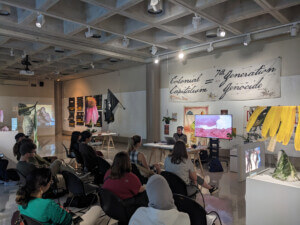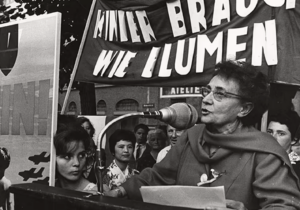From an Islamic cemetery in Austria to a 330-meter bridge in North Africa, the five recipients of the 2013 Aga Khan Award for Architecture each address a concern within their culture to improve quality of life. Awarded every three years since its 1977 initiation, the competition grants a collective $1 million to a number of projects that exist in areas with a significant Muslim population. Each project must be culturally receptive and increased merit is given to those that use local resources in ways that may motivate analogous ventures in the future.
The 2013 Aga Khan Award winners are as follows:
Salam Center for Cardiac Surgery in Khartoum, Sudan
From AK Award and Studio Tamassociati:
The Salam Centre for Cardiac Surgery consists of a hospital with 63 beds and 300 local staff, with a separate Medical Staff Accommodation Compound sleeping 150 people. The centre is built as a pavilion in a garden with both primary buildings organised around large courtyards. The hospital block is of the highest technical standard with complex functions including three operating theatres optimally placed in relation to the diagnostics laboratories and ward. Mixed modes of ventilation and natural light enable all spaces to be homely and intimate yet secure. Seeing the abandoned containers that had been used to transport construction materials for the Salam Centre for Cardiac Surgery, the architects were inspired to reuse them to house the centre’s staff. Ninety 20-foot containers form the accommodation block, each unit consisting of 1.5 containers, with a bathroom and small veranda facing the garden. Seven 40-foot containers are occupied by a cafeteria and services. Insulation is through an ‘onion system’ of 5-centimetre internal insulating panels and an outer skin comprising a ventilated metal roof and bamboo blinds. A solar farm powers the water-heating system.
Revitalization of Birzeit Historic Centre in Birzeit, Palestine
From AK Award and Riwaq – Centre for Architectural Conservation:
This five-year project, part of a rehabilitation master plan initiated by Riwaq, has transformed the decaying town of Birzeit, created employment through conservation and revived vanishing traditional crafts in the process. Community involvement was encouraged from the start, including local NGOs, the private sector, owners, tenants and users, all working with the municipality. Both historic buildings and public spaces have been rehabilitated into community activity hubs. Replaced sections of wall remain distinguishable from the original structures, without harming architectural coherence. Lost features were replaced where there was clear evidence for their former appearance, such as floor tiles with Palestinian motifs. Affordable traditional techniques and local materials were used throughout. Where no historical models were available, new elements were made in a bold contemporary spirit.
Rabat-Salé Urban Infrastructure Project in Morocco
From AK Award and Marc Mimram Architecture:
Linking Rabat and Salé to form an urban hub, the Hassan II Bridge and its associated access works relieve both cities’ historic sites and populations of atmospheric and sound pollution. The design respects the overwhelming horizontality of the built and natural environments, allowing Rabat’s 12th-century Hassan Tower to retain its vertical dominance of the skyline. The concrete supports, in subtly varying arced forms, are deliberately delicate and lace-like in appearance. Besides providing transport connections, the structure also offers an urban roof over the alluvial plain of the Bouregreg River, creating a protected public space for markets and leisure activities.
Rehabilitation of Tabriz Bazaar in Tabriz, Iran
From AK Award and ICHTO East Azerbaijan Office:
The Tabriz Historic Bazaar Complex was officially protected in 1975 and has been covered by special stewardship measures until 2010, when it was added to the World Heritage List. The complex covers 27 hectares with over 5.5 kilometres of covered bazaars. Three different protection areas have been established (a nominated area, a buffer zone and a landscape zone), subject to special regulations incorporated into the planning instruments. The management framework is based on the participation of the ‘bazaaris’, together with municipal authorities and ICHTO’s Tabriz Bazaar Base. Since 2000, numerous complexes within the bazaar have been rehabilitated with the participation of the owners and tenants. Infrastructure has been improved and public facilities have been built.The Tabriz Bazaar is a unique example of urban conservation and development project in which heritage plays a catalyst role in rejuvenating the tangible and intangible memory of the historic city of Tabriz.
Islamic Cemetery in Altach, Austria
From AK Award and Bernardo Bader Architects:
The Cemetery serves Vorarlberg, the industrialized westernmost state of Austria, where over eight percent of the population is Muslim. It finds inspiration in the primordial garden, and is delineated by roseate concrete walls in an alpine setting, and consists of five staggered, rectangular grave-site enclosures, and a structure housing assembly and prayer rooms. The principal materials used were exposed reinforced concrete for the walls and oak wood for the ornamentation of the entrance facade and the interior of the prayer space. The visitor is greeted by and must pass through the congregation space with its wooden latticework in geometric Islamic patterns. The space includes ablution rooms and assembly rooms in a subdued palette that give onto a courtyard. The prayer room on the far side of the courtyard reprises the lattice-work theme with Kufic calligraphy in metal mesh on the ‘qibla’ wall.










